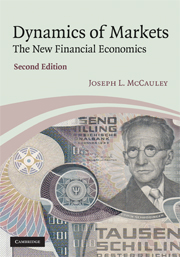Book contents
- Frontmatter
- Contents
- Preface to the second edition
- 1 Econophysics: why and what
- 2 Neo-classical economic theory
- 3 Probability and stochastic processes
- 4 Introduction to financial economics
- 5 Introduction to portfolio selection theory
- 6 Scaling, pair correlations, and conditional densities
- 7 Statistical ensembles: deducing dynamics from time series
- 8 Martingale option pricing
- 9 FX market globalization: evolution of the Dollar to worldwide reserve currency
- 10 Macroeconomics and econometrics: regression models vs empirically based modeling
- 11 Complexity
- References
- Index
1 - Econophysics: why and what
Published online by Cambridge University Press: 02 December 2010
- Frontmatter
- Contents
- Preface to the second edition
- 1 Econophysics: why and what
- 2 Neo-classical economic theory
- 3 Probability and stochastic processes
- 4 Introduction to financial economics
- 5 Introduction to portfolio selection theory
- 6 Scaling, pair correlations, and conditional densities
- 7 Statistical ensembles: deducing dynamics from time series
- 8 Martingale option pricing
- 9 FX market globalization: evolution of the Dollar to worldwide reserve currency
- 10 Macroeconomics and econometrics: regression models vs empirically based modeling
- 11 Complexity
- References
- Index
Summary
Why econophysics?
This is the era of growing financial instability, a new era of worldwide privatization and deregulation made possible by a vast credit expansion based on the Dollar as the worldwide default reserve currency. Derivatives are unregulated and are used as a form of money creation totally beyond the control of any central bank. Standard economic theory completely rules out the possibility of such instability.
Before WWII, the expansion of a currency and consequent inflation was not possible with the Dollar regulated by gold at $35/oz. The gold standard was finally and completely abandoned by the USA in 1971 after “Eurodollars” became on the order of magnitude of the US gold supply. On the gold standard, hedging foreign currency bets apparently was not necessary. We can date our present era of inflation, credit, and high level of consumption with increasing finance market instability from the deregulation of the Dollar in 1971, and it's not accidental that both the Black–Scholes derivatives model and the legalization of large-scale options trading both date from 1973. We can contrast this reality, described in popular books by Stiglitz (2002), Morris (2008), and Soros (2008), with the teaching of equilibrium in standard academic economics texts.
Economists teach market equilibrium as the benchmark in the classroom, even while the real world of economics outside the classroom experiences no stability. There is an implicit assumption in those texts that unregulated markets are stable, as if completely free markets should somehow self-organize in a stable way.
- Type
- Chapter
- Information
- Dynamics of MarketsThe New Financial Economics, pp. 1 - 9Publisher: Cambridge University PressPrint publication year: 2009



